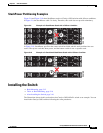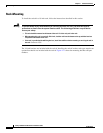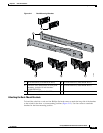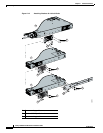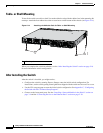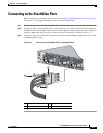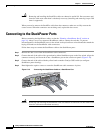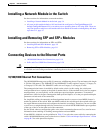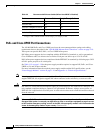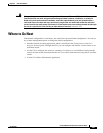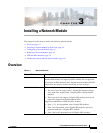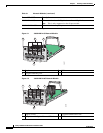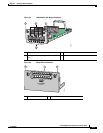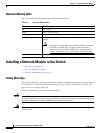
2-19
Catalyst 3850 Switch Hardware Installation Guide
OL-26779-02
Chapter 2 Switch Installation
Installing a Network Module in the Switch
Installing a Network Module in the Switch
See these sections for information on network modules:
• Installing a Network Module in the Switch, page 3-4
• All ports in this module default to 10G and should be configured as TenGigabitEthernet1/1/1
through TenGigabitEthernet1/1/4, even when you are operating them as 1G using SFPs. There are
only four interfaces which are valid and the other four should not be used even though they still show
up in the CLI., page 3-7
Installing and Removing SFP and SFP+ Modules
See these sections for information on SFPs and SFP+:
• Installing SFP and SFP+ Modules, page 3-9
• Removing SFP or SFP+ Modules, page 3-11
Connecting Devices to the Ethernet Ports
• 10/100/1000 Ethernet Port Connections, page 2-19
• PoE+ and Cisco UPOE Port Connections, page 2-20
Caution Category 5e and Category 6 cables can store high levels of static electricity. Always ground the cables
to a suitable and safe earth ground before connecting them to the switch or other devices.
10/100/1000 Ethernet Port Connections
The 10/100/1000 Ethernet ports use RJ-45 connectors with Ethernet pinouts. The maximum cable length
is 328 feet (100 meters). The 100BASE-TX and 1000BASE-T traffic requires Category 5, Category 5e,
or Category 6 UTP cable. The 10BASE-T traffic can use Category 3 or Category 4 cable.
The autonegotiation feature is enabled by default on the switch. At this setting, the switch ports
configure themselves to operate at the speed of attached device. If the attached device does not support
autonegotiation, you can explicitly set the switch port speed and duplex parameters. To maximize
performance, either let the ports autonegotiate both speed and duplex, or set the port speed and duplex
parameters on both ends of the connection.
For simplified cabling, the automatic medium-dependent interface crossover (auto-MDIX) feature is
enabled by default on the switch. With auto-MDIX enabled, the switch detects the required cable type
for copper Ethernet connections and configures the interface accordingly. Therefore, you can use either
a crossover or a straight-through cable for connections to a switch 10/100/1000 Ethernet port regardless
of the type of device on the other end of the connection.
See the switch software configuration guide or the switch command reference on Cisco.com for more
information about enabling or disabling autonegotiation and auto-MDIX.
If auto-MDIX is disabled, use the guidelines in Table 2-2 to select the correct cable for connecting the
switch 10/100/1000 Ethernet ports to other devices. See the “Cable and Adapter Specifications” section
on page B-5 for cable-pinout descriptions.



